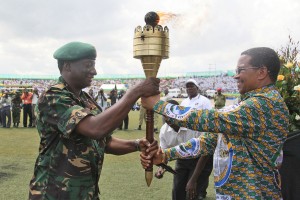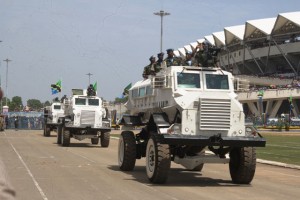
President Jakaya Kikwete hands over the Uhuru Torch (mwenge) to the Chief of Defence Forces, General Davis Mwamunyange, at the end of the countrywide Torch race in Dar es Salaam. Gen Mwamunyange later presented the Torch to a team that took it to the peak of Mount Kilimanjaro. Photo – State House.
In Dar es Salaam, the celebrations started in earnest in July. Ministries took turns to showcase their activities at the Mnazi Mmoja grounds.
Then on 9th December, over 40 Heads of State, Government and other dignitaries attended the main celebrations which included a guard of honour by the country’s armed forces and a 21-gun salute to the Commander-in-Chief.
There was a display of the army’s equipment ranging from tanks, armoured vehicles to trucks and other vehicles used in warfare. A number of fighter jets were flown in synchronized formations over the stadium. Some 4,500 children from primary and secondary schools entertained guests with a mass performance followed by traditional dances by four different traditional groups, hand-picked to proportionally represent Tanzania. The dances included Selo from Coast Region, Ngongoti from Mtwara Region as well as Msewe and Bugobogobo from Zanzibar and Mwanza respectively.
President Kikwete’s speech
President Kikwete said that some historical factors were to blame for the country’s failure to attain higher levels of development as many people would have wished. He said that when Tanganyika gained independence from Britain in 1961, it was a very poor country with poor infrastructure and a relatively small pool of skilled manpower. “We had only twelve university graduates when we got independence and some people feared it would be almost impossible to attain reasonable levels of development,” the President noted, adding: “With the cooperation amongst leaders in all phases of the government since independence and the general public, our country is where it is now…we have made big steps.”
The colonial government, he explained, had no intention of developing the country but just wanted to exploit its resources.
“But Mwalimu Julius Nyerere and his colleagues vowed to fight for our independence and help Tanzanians climb out of abject poverty.” The President also pointed out that many big challenges lay ahead.
Britain’s congratulations
Queen Elizabeth II congratulated Tanzania on the 50th independence anniversary. She wrote that the 50 years had been characterized by peace and stability, a rare thing to find in many other parts of the world. “It gives me great pleasure in sending your Excellency and the people of Tanzania my warmest congratulations on this very special occasion,” she said.
“The Prince of Wales and Duchess of Cornwall have told me how much they enjoyed your hospitality during their recent visit to your country as part of the celebrations for this special event. I wish Your Excellency and the people of Tanzania, my best wishes for growing prosperity in the coming years.”
Fifty years ago HRH the Duke of Edinburgh, representing the Queen, was in Dar es Salaam at the ceremonies connected with the handing over of power from Britain to the new country, then known as Tanganyika. Fifty years later in November 2011 his son Prince Charles was in Dar es Salaam to join in the 50th anniversary of those momentous events.
Security
Tanzania tightened security to guarantee the safety of 14 foreign Heads of State and Government who came to mark Tanzania Mainland’s 50 years of independence. Prime Minister Mizengo Pinda, said the government had upped the security profile as a precaution against threats from the Somalia-based Al Shabaab terror group.
The costs
Many people complained about the cost of the celebrations in view of Tanzania’s shortage of funds for all kinds of development projects.
According to the Citizen the government spent a total of TShs 64 billion to facilitate the celebrations. Some TShs 8 billion was allocated to local governments. Regional administrations and local government authorities organised celebrations in all of the mainland’s 21 regions, and 136 district councils.
Major items of expenditure included preparatory logistics, fuel, per diems for civil servants and printing costs for leaflets highlighting achievements that respective districts and regions had registered over the 50-year period.
About TShs 213 million was given to Tanzania Trade Development Authority to finance ministerial exhibitions as well as those of state agencies and the private sector, at the Mwalimu Nyerere exhibition grounds along Kilwa Road in Dar es Salaam.
The Ministry of Industries, Trade and Marketing reportedly received TShs 30million. Each of the nearly 5,000 youngsters who participated in the mass display was reportedly paid TShs 40,000 (£16).
Ubungo MP John Mnyika (Chadema) said the money should have been channelled into development projects. The Uhuru anniversary would have been more memorable if the money had been spent on settling teachers’ debts, as well as those of other public employees. “We could also have spent the money on building feeder roads in Dar es Salaam, to ease congestion on the few major roads… people would have remembered that for a long time,” he said.

